Fair Isle Wildlife Club
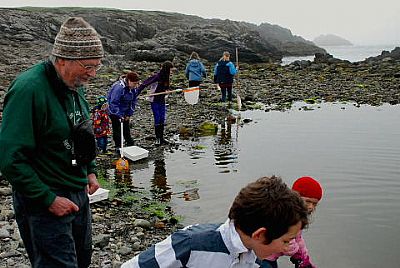
Fair Isle “Wildlife Club” is particularly popular with the island children and their parents but is open to all and, during the tourist season also attracts visitors staying at the bird observatory and other accommodation outlets.
Activities include simple monitoring, ecological studies and extending biodiversity knowledge, for instance within coastal habitats, the shoreline and rock pools.
Fair Isle Wildlife Club session held during Fair Isle Martime Festival, 24th May, 2014.
(Following photos courtsey of Cape Farewell Project members Deidre Nelson & Ruth Little.)
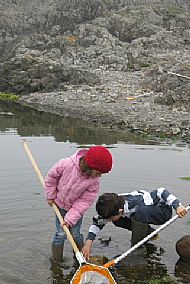
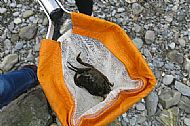
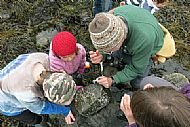
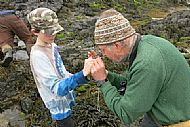
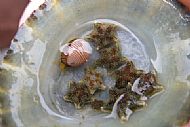
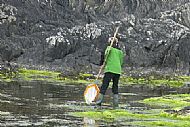
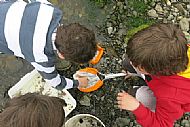

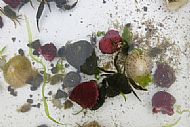
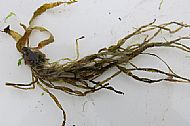
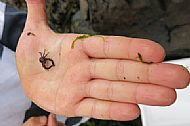
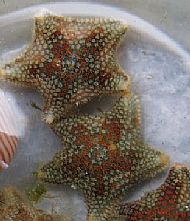

FAIR ISLE WLDLIFE CLUB
Muckle Uri and Smirri Geos, 24th May 2014
There was a good turn out of children and adults for a Fair Isle Wildlife Club investigation of the rock pools and Muckle Uri and Smirri Geos. The list below is far from complete but gives some of the highlights, including NEW discoveries for Fair Isle.
Seaweeds
Chipolata weed Scytosiphon lomentaria
False pepper dulse Osmundea hybrida
Bryozoan
Sea-mat Membranipora membranacea
Sponges
Purse sponge Grantia compressa
Pseudosuberites sulphureus NEW
Marine worms
Red-thread Cirriformia tentaculata NEW
Lepidonotus clava a scale-worm
Crustaceans
Common shore crab Carcinus maenas – lots
Pennant’s nut-crab Ebalia tuberosa – only previous record 40 m deep offshore
Oceanic sea-slater Ligia oceanica
Granulated sea-slater Idotea granulosa
Sand-hopper Talitrus saltator (very common on Fair Isle but not in d/base)
Molluscs
Shag-rug sea-slug Aeolidia papillosa
White tortoiseshell limpet Tectura virginea
Thick-lipped dog whelk Hinia incrassata
Lepidochitona cinereus a coat-of-mail shell
Painted top-shell Calliostoma zizyphinum with hermit crab occupant
Spotted cowrie Trivia monacha
Arctic hiatella Hiatella arctica NEW
Musculus discor 2 mm long mussel (very common on Fair Isle but not in d/base)
Omalogyra atomus tiny snail less than 1 mm across
Starfish and allies
Common starfish Asterias rubens
Small cushion-star Asterina phylactica large, expanding population, northernmost World site
Edible sea-urchin Echinus esculentus
Sea-squirt
Corella parallelogramma NEW
Fish
3-spined stickleback Gasterosteus aculeatus
5-bearded rockling Ciliata mustela
butterfish Pholis gunnellus
(Photos of some these species can be seen above.)

The following extracts about the Fair Isle Wildlife Club are from FIMETI's Annual Newsletter 'Making Waves'.
FIMETI Newsletter no. 9 March 2012
Fair Isle Wildlife Club
Some Fair Isle Wildlife Club members sampling marine life in Fair Isle’s North & South Havens on 4th June, 2011.
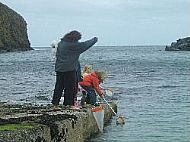

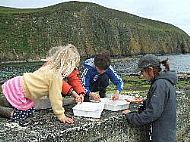 Photos: Copyright EA Riddiford
Photos: Copyright EA Riddiford
Time constraints on the leader and inclement weather limited the number of Fair Isle Wildlife Club activities in 2011.
The programme did, however, include activities with the island, visitors and workcamps, and visiting yacht crews during the Tall Ships Race stop-over.
Themes were Arctic-Alpine plants of Ward Hill, coastal biodiversity, plankton of North Haven and rare plants of the coastal fringe.
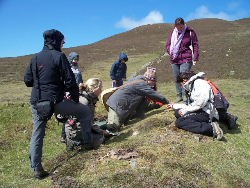 Photo: Copyright TH Hyndman
Photo: Copyright TH Hyndman
FIMETI Newsletter no. 7, February 2010
Fair Isle Wildlife Club
The Fair Isle Wildlife Club (FIWC) continues to engage people of all ages in appreciating and learning about their environment, marine and terrestrial. Though originally set up for the community it has always been open to all and the make up of the groups is often international. Two-thirds of the participants are normally from the isle but in summer particularly the group is much more cosmopolitan, including in 2009 a “workcamp special” for the NTS Thistle Camp. Activities were as varied as ever in both years and included visits to the shore at different times of year to study the life of rock pools, the seashore and tideline, between the tides, seaweeds, plankton and jellyfish, etc. Reports of the visits are posted on the Fair Isle website www.fairisle.org.uk.
Equipment grant: National Trust for Scotland
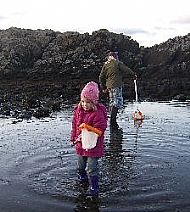
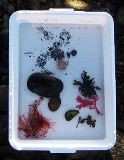
Photos: Copyright NG Riddiford.
One of the great additions in 2009 has been the purchase of a series of long-handled pond-dipping nets. This was achieved by means of a generous grant from the NTS through their Concordat with Scottish Natural Heritage to obtain equipment for the Wildlife Club. We are extremely grateful to both organisations. A range of net sizes was obtained, including smaller lighter nets designed especially for the youngest participants. Further equipment is being purchased under the same grant for use in 2010.
Our thanks to Meiji
Fair Isle Wildlife Club excursions to the shore have revealed a fascinating world from the shore crabs Carcinus maenas and small fish, so addictive to children, to minuscule creatures only fully appreciated through high magnification. In order to share in these marvels, participants have had to stand patiently in line waiting their turn to peer through a microscope. We are pleased to announce that this will be a thing of the past.
Thanks to a very generous gesture from Meiji Techno, FIWC/FIMETI now has at its disposal a state-of-the art microscope camera which not only takes still photographs of minute creatures but can be set up to feed live pictures through to a computer. This means that minuscule marine fauna and flora can be viewed directly by all, just by gathering round a computer. It will open up a new world.
Meiji Techno is a great supporter of conservation programmes and provided the camera at a huge discount – in effect, sponsoring environmental education on the isle.
It has taken us (Elizabeth and Nick Riddiford) a little while to master the workings of the camera but we now feel confident with it and look forward to putting it into action in 2010. Meanwhile here are a few of our early attempts at microphotography.
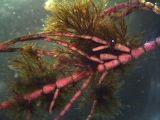
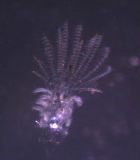
Photo: Left. The epiphytic seaweed Sphacelaria on Corallina officinalis. Copyright N.J.Riddiford. Photo, right: Feeding mechanism of barnacle, top lit. Copyright N.J. Riddiford.
We are very pleased to acknowledge the generosity of Meiji Techno and the informed, thoughtful advice of its staff. Meiji Techno supplies a wide range of high quality material for exploring the microscopic world further. If anyone else is tempted, details of its products can be found at www.meijitechno.co.uk.
REPORTS OF TWO OF OUR WILDLIFE CLUB ACTIVITIES
Terrestrial and marine treasures at South Light
There was an excellent turn-out for a Fair Isle Wildlife Club session at South Light on Friday evening, 25th May, 2012. The area is one of many high quality natural history sites on the isle with the added advantage of terrestrial interest and accessible marine life, particularly at low tide.
We started by looking at the coastal grassland which, despite its name, has relatively little grass cover – the green being contributed largely by the leaves of a rich mix of three species of plantain, including a distinct maritime form of the ribwort plantain Plantago lanceolata, sea squill Scilla verna and thrift Armeria maritima.
The rocks immediately south-east of South Light have some specialised plants such as sea mouse-ear Cerastium diffusum, and a very strong population of the rare lichen Anaptychia ciliaris mamillata. The only other known Scottish site for this lichen is on the banks of the Clyde so this was the northernmost UK record….. until recently when I found other tiny colonies along the east cliffs as far as Goorn.

PHOTO: Danish Scurvy Grass (Deidre Nelson)
Tucked in below the Light on the south-west side were some pretty patches of Danish scurvy-grass Cochlearia danica. This tiny white-flowered plant was used in past times by sailors to ward off scurvy (thanks to Peter Evans for this information). A more robust form growing from cracks in the rocks is considered by some as Scottish scurvy-grass Cochlearia scottica. The Danish scurvy-grass clearly prefers more sheltered, sunny sites. We use plants a lot as “bio-indicators”, e.g. of soil types, nutrient enrichment, etc. My wife thinks that Danish scurvy-grass should be used as a bio-indicator for sunbathing spots!
Moving on: we had nets with us and it took no prompting to switch our attention to the series of rock pools exposed at full low tide at Smirri Geo. Captures were emptied into white pans filled with seawater so that people could see what was being caught. The bairns particularly were amazing, finding all sorts of interesting beasties. Most notable of all was the abundance of small cushion-stars Asterina phylactica.
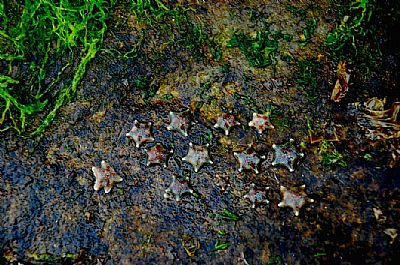
PHOTO: Small Cushion Star (Ruth Little)
Prior to a single individual being discovered by Henry Hyndman four years ago the northernmost known World site was 400 km farther south. By last year a small population had become established but was restricted to the rocks of one very low tide pool about 2 m across. On this visit the bairns were finding it throughout the geo.
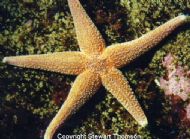
PHOTO: Asterias rubens. Copyright Stewart Thomson
The Asterina was one of five species of starfish located. The others were the common starfish Asterias rubens, the common brittle-star Ophiothrix fragilis, the small banded brittle-star Ophiactis balli and plenty of the small brittle-star Amphipholis squamata. A small partan (edible crab) Cancer pagurus was the largest item captured.
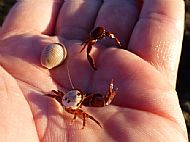

PHOTOS Copyright TH Hyndman
A long-clawed porcelain crab Pisidia longicornis and a juvenile common squat lobster Galathea strigosa were also intercepted.
Two tiny fish were netted. One was a juvenile lumpsucker Cyclopterus lumpus. The other was a goby. It was also a juvenile and thus difficult to identify but appears to be a painted goby Pomatoschistus pictus, a species not previously recorded from the isle, though common enough in Shetland. Amongst other groups there was a ragworm, probably Nereis versicolor – yet again a juvenile.
Participants were fascinated by an unusual-looking mollusc. Its shell comprised a series of overlapping plates which gives it its common name of coat-of-mail shell (also known as a chiton). There are several species but this one was Lepidochitona cinereus, the most frequently encountered species on Fair Isle and generally in the UK. A small winkle handed to me was indeed the small winkle Melarhaphe neritoides.
Some of the captures were brought back to Schoolton to confirm identifications. Hidden amongst tufts of seaweed were two tiny snails, neither exceeding 2 mm. The smallest, a spire shell, proved to be Rissoella diaphana – a species new to Fair Isle (or at least to the FIMETI database); the only slightly larger Omalogyra atomus is disc-shaped. I have encountered this species before.
We spent more time with invertebrates than with seaweeds. However, I was able to explain to those who did not know that the green “mushrooms” scattered abundantly across the rocks were holdfasts from which would grow new plants of the thong-weed Himanthalia elongata, full grown examples of which draped the rocks and choked many of the deeper rock-pools. The rocks and larger seaweeds also support epiphytic algae. I brought back a couple of tiny tufts, which proved to be Derbesia marina and Elachista fucicola. These are also additions to the FIMETI database, but to be expected.
It was a terrific excursion in lovely sunshine and for those less inclined to delve into the deepest pools there was the bonus of soaking up the late evening sun from the rocks above. The amount of biodiversity information obtained from such excursions cannot be underestimated and I would like to thank all the bairns and adults, residents and visitors, who participated with such industry and enthusiasm.
Nick Riddiford (FIMETI)
Plankton in North Haven, 4th June 2011
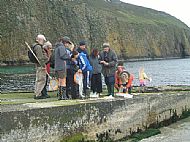

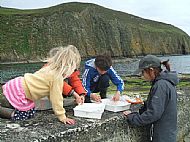
The Fair Isle Wildlife Club has returned to action, taking as its main investigation “Plankton in North Haven”. Suggested by Henry Hyndman, it was certainly a good choice as the haven proved full of plankton. There were large amounts of one of the opossum shrimp group which proved to be the chameleon shrimp Praunus flexuosus – so called because it can change colour depending on the background. As ours were in open water, they were entirely transparent apart from the gut; we could see what they had for breakfast! If these were small, other members of the “cloudy” water were minute.
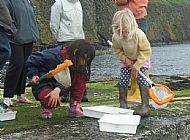
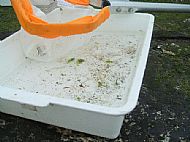
Divers will tell you that Fair Isle has some of the clearest waters anywhere in the British Isles, but in summer that clarity can be reduced by the density of plankton. The tiny dots swimming around in the samples were clearly copepods with their “cyclops” eyes but it was only when I returned home and peered through a microscope that I was able to determine that at least four species was involved. The most abundant by far was a Calanid copepod which may have been Pseudocalanus elongatus. All my plankton identifications must be considered tentative as I am no expert. However, the other species, in order of decreasing abundance, showed features of Temora longicornis, Calanus cf. helgolandicus and Zaus spinatus.
The closely related Calanus finmarchius, once abundant in summer and an important element of the food chain (a major resource for sand-eels) our waters, started to disappear from our waters in the late 1980s and by the mid 1990s had completely gone, moving north to cooler waters. Could Calanus helgolandicus being filling the void? Let’s hope so.
Tiny species are hard to appreciate with the naked eye, but a few larger invertebrates were taken. There were two species of gammarid shrimp, Gammarus locusta and Atylus swammerdami. The first, at least, is a common coastal species on Fair Isle.
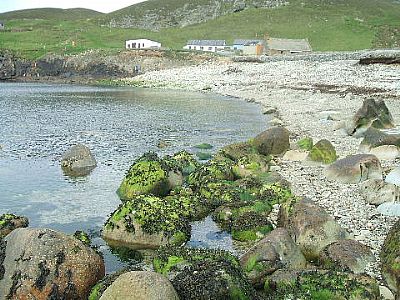
Though the main focus was the zooplankton, our attention was also drawn to the seaweeds. There were detached species floating amongst the plankton and, later on, we paid attention to attached species. Scientific names are not “user-friendly” for many people but fortunately there has been a recent move to give even some of the more obscure seaweeds an English name. These are included in the newly published seasearch Guide to Seaweeds of Britain and Ireland, which I had with me.
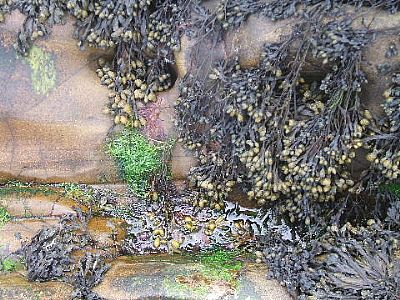
We had some fun looking up the “captures”, not least the delightfully named Bunny Ears Lomentaria articulata which has side shoots along the stipe which look for all the world like the fore-mentioned rabbit aural appendages.
The havens is a good place to compare the common wracks and I was able to lay alongside each other examples of the knotted wrack Ascophyllum nodosum, toothed wrack Fucus serratus, spiral wrack Fucus spiralis and bladder wrack Fucus vesiculosus. Growing in profusion on the knotted wrack were the dense dark red tufts of the wrack siphon weed Polysiphonia lanosa.
Amongst the fragments of seaweed floating with the plankton were almost entire plants of the green branched weed Cladophora sericea, lots of sea lettuce Ulva lactuca, fragments of soft feather weed Plumaria plumosa and pieces of kelp frond. Many of these support their own ecosystems. One small fragment of kelp frond supported a large colony of the hairy sea-mat Electra pilosa, an even tinier bryozoan, several small patches of breadcrumb sponge Halichondria panicea overgrowing the sea-mat and a series of epiphytic seaweeds which include the elongate siphon weed Polysiphonia elongata, and feathered wing weed Ptilota gunneri.
Tiny brown tufts of an Audouinella species adorned the Cladophora and the sea lettuce harboured the biggest surprise of all, a tiny jewel anemone Corynactis viridis. This was a surprise because all references state that it is found on hard substrates, such as rocks, underwater cliffs and caves. Henry found one a few days earlier floating amongst the plankton so perhaps young individuals disperse away from the parent and settle, at least temporarily, on other substrates.
I spent some time studying an “ostracod” nestled within the sea lettuce before it dawned on me that it was something else. I eventually tracked it down to the final larval stage of Semibalanus balanoides, one of the acorn barnacles. This larval stage looks like a tiny bean with legs and antennae protruding – very, very different from the adults fixed on rocks and hidden below chalky plates.
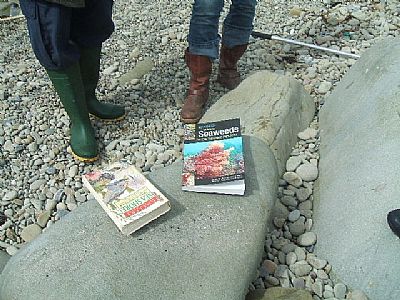
Several participants were impressed by the new seaweed book. Beautiful photos accompany clear, straightforward descriptions and a UK map which includes Fair Isle! This allows me to conclude that the elongate siphon weed is a first Fair Isle record, though not surprising as it is known from much of Orkney and Shetland. For those tempted, the seaweed book is available from the Marine Conservation Society, price £16.90.
Nick Riddiford (FIMETI)
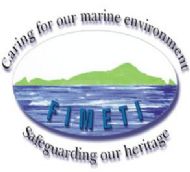
Text and photographs Copyright Fair Isle Marine Environment and Tourism Initiative. All rights reserved.

